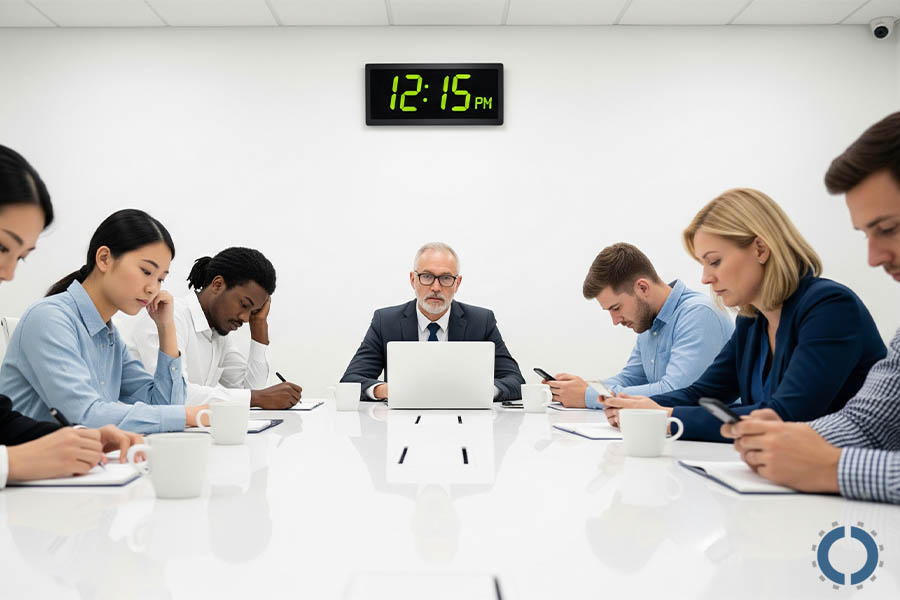How to Get The Most From Your Office Meetings

Almost all of us have had the experience of attending meetings that were held without a clear goal, took up a lot of our time, and ultimately had no clear outcome.
These types of meetings not only reduce work efficiency but also cause mental fatigue and reduce employee motivation.
Now the question is: how to get the most from your office meetings.
To get the most from your office meetings, start with a clear agenda and stick to it.
Only invite people who are essential.
Begin and end on time, define action items clearly, and follow up after the meeting.
Use AI tools like automatic note-takers to capture key points and keep meetings focused.
Keep it short, purposeful, and outcome-driven — not just a calendar filler.
On the other hand, one of the hidden factors that affects the quality of meetings is office furniture and the layout of the meeting space.
By outfitting your conference rooms with office furniture Houston companies rely on for ergonomic comfort and smart functionality, you create an environment where ideas flow, participants stay engaged, and time is used wisely.
Professional layout, ergonomic chairs, well-designed tables, proper lighting, and even the placement of meeting equipment can have a significant impact on focus, engagement, and meeting outcomes.
In this article, you’ll learn how to turn work meetings into effective tools for team growth with a few simple principles — from purposeful planning to using the right furniture and layout.
The Never-Ending Meeting
It’s Friday, late morning. There was a monthly progress meeting scheduled at eleven and was supposed to last an hour. The person in charge of the office meeting was reading her reports when one particular metric caught the ire of another meeting attendee, who began ranting (professionally) about how that specific item is measured.
After the person reading the reports responded with her justification for the data, she continued with the other topics. Once she finished, a touch early even, the disgruntled attendee chimed in again, bringing the issue back to that metric from earlier.
This turned into a discussion between the two, and after twenty minutes, it felt like it was just going in circles. After the sixty-minute mark, people’s faces started to display frustration, simply wanting the meeting to end.
Finally, the meeting ended with the discussion between the two not achieving anything particularly significant.
Wasted time and money
Many share aggravation with meetings. Ponder the following observations about the affliction of ineffective meetings in today’s workplace:
- The average executive attends 62 office meetings a month
- Over a third are considered a waste of time by those executives
- On average, fifteen percent of an organization’s collective time is spent in meetings
- Based on the average time spent in meetings, and a third of that time is wasted, the estimated bill for wasted time is roughly $37 billion a year in the U.S.
David Grady and Jason Fried, ‘The Economic Impact of Bad Meetings,’ TED talk, 17 November 2014
Nine no-brainer rules for getting the most from your meetings
1. Be clear about who is directing the meeting and the purpose it is meant to serve.
Every office meeting you have should be aimed at accomplishing someone’s goals; that person should be the one responsible for the meeting and should decide what they want out of it and how that will happen. Meetings without someone unquestionably in charge are at high risk of being without clear direction and therefore unproductive.
2. Be clear about the style of communication you use based on objectives and priorities.
If the goal is for people with differing opinions to work through their differences and attempt to get closer to a compromise (i.e., open-minded debate), the office meeting will run differently than if the goal is to educate.
Debating can take much time, and that time will increase exponentially as the number of people participating increases, so choose the right people in the right quantity for that specific objective. In any discussion, be sure to limit participation to those whom you value most for that objective.
Choosing people because their conclusion aligns with yours is the absolute worst practice. Groupthink (people not asserting individual views) and solothink (people being unwilling to consider the thoughts of others) are both hazardous.
3. When leading the discussion, be assertive but open-minded.
Resolving different perspectives can often be both difficult and time-consuming. It’s the responsibility of the office meeting leader to try and balance the conflicting perspectives while pushing through impasses to use the time wisely.
What if someone inexperienced offers their opinion? Exploring the views and opinions of people still building their track record can give valuable insight into how they may handle new responsibilities. Time permitting, work through their reasoning so they can understand how their perspective might be wrong, but it’s also vital to open-mindedly consider if they might be right.
4. Beware of “topic slip.”
Topic slip is the random drifting from topic to topic without the resolution of any of them. One method to avoid this is to keep track of the conversation on a whiteboard so everyone can see the discussion as it unfolds and stay on track.
5. Enforce logic in conversations.
People can get heated when there is disagreement. Always remain calm and analytical. Remember, also, that emotions can skew how a person sees reality. For example, when someone says, “I feel that (something is true)” and continues as though it is fact, even though others may have a different interpretation, ask them, “Is it true?” to try and ground the conversation in reality.
6. Don’t lose personal responsibility in group decision-making.
Too often, groups will decide to do something without clearly delegating responsibilities, so no one is clear about who is supposed to do what and follow up with whom. Be clear in delegating responsibilities.
7. Use the “two-minute rule” to limit unproductive interruptions.
The two-minute rule states that you have to allow someone that period of time, entirely uninterrupted, to explain their thoughts before stepping in with your own. This will ensure everyone has time to fully hash out and communicate their thoughts without the concern that they will be misunderstood or trampled over by a louder voice.
8. Watch out for fast talkers.
Fast talkers speak faster than their words can be scrutinized, to push their agenda past others’ examination and objections. Fast-talking is most effective when used against people concerned with appearing stupid. Don’t be those people. Recognize your responsibility to make sense of things, and don’t move forward until you do. If you’re feeling pressured, say something to the effect of, “Sorry for being dumb, but I’ll need you to slow down so I can understand what you’re saying.”
9. Resolve conversations.
The objective of a discussion is to realize completion by getting everyone in sync, which in turn leads to decisions and action. Conversations failing to achieve completion are a waste of time. When there has been an exchange of ideas, it is imperative to wrap up by stating the conclusions.
When there is agreement, verbalize it; if not, verbalize that. When further action is needed, put those tasks on a to-do list and delegate people to get them done, specifying due dates. Document your conclusions, any working theories, and the to-do list in a place that will lead to their use as a foundation for continued progress. To make this happen, assign a note-taker.
Is Your Meeting Space Outdated And Dysfunctional?
You’ve gathered together your top employee talent and are ready to knock out some important goals. If, after the meeting, you’re left wondering why nothing was actually accomplished, take a look around your meeting space? How is the seating? Is the table large enough to provide ample workspace? Do you have technology readily available? How about charging station and ample outlets? All these things matter for a great meeting.
Wow! Whether you organize meetings or simply attend them, it’s worth your time to become more effective at this professional skill. Imagine the gains that could be achieved if your company were even 5% better at meetings.
Optimizing Your Meeting Space: The Role of Furniture and Layout
1. Ergonomics and Comfort
If you want to know how to get the most from your office meetings, you should consider the comfort of meeting furniture.
The physical comfort of meeting participants directly affects their focus, participation, and productivity.
When people feel tired or uncomfortable during a meeting, they are less likely to actively participate, and meetings become of poor quality.
This is where the ergonomics of office furniture plays a vital role.
- Chairs: The right chair for business meetings should have a number of key features.
The meeting chair should be comfortable and soft, but not so soft that it makes you feel sleepy.
A good office chair should also have proper lumbar support to reduce pressure on the spine, especially during long sessions.
The ability to adjust the height, armrests, and back angle is another feature of a chair suitable for office meetings, so that each person can adjust it based on their height and preference.
If the chairs are not ergonomic, after 20–30 minutes, people will start to shift, become restless, or lose interest in the meeting.
- Table Height: The meeting table should be at a standard height so that people can comfortably write or place their laptops on it.
People should be able to type or take notes without strain on their wrists or shoulders.
Also, people in the meeting should be able to bend or straighten easily while speaking without feeling uncomfortable.
If the desk is too high, people have to keep their shoulders up, which causes fatigue.
If the table is short, people will lean forward, which hurts their backs.
2. Layouts for Collaboration and Dynamics
The way tables and chairs are arranged in meetings directly affects the interaction, level of participation, and psychological atmosphere of the meeting.
Each type of layout is suitable for a specific purpose, and understanding them will help you to get the most from your office meetings.
- Boardroom Table: This table is suitable for formal presentations, business negotiations, structured decision-making, or management meetings.
The design of this table is such that it suggests a hierarchical structure, with the focus of power and attention often being at the head of the table.
- Circular or Oval Table: This type of table is suitable for brainstorming, collaborative meetings, and open discussions.
Circular and oval tables create a sense of equality among all members, and there is no hierarchy.
They also increase direct eye contact and friendly communication.
These tables encourage participation and make the space more democratic.
- U-Shape Layout: Suitable for presentations and workshops that require direct interaction between the presenter and participants.
The presenter sits in the middle of the U and can interact directly with everyone.
In this design, participants can also interact visually with each other.
- Modular Furniture: This type of furniture is suitable for multipurpose spaces, meetings with variable structures, teamwork, and group division.
Modular furniture allows for the ability to quickly move and rearrange tables and chairs.
The meeting can also be easily switched from formal to small groups and vice versa.
3. Seamless Technology Integration
In today’s business, an effective meeting is almost impossible without the use of digital tools.
These tools should be integrated intelligently into the office space and furniture to maintain focus, order, and productivity.
- Integrated Power and Data: Meeting tables should have power, USB, and network ports in accessible locations.
This allows the user to conveniently charge their laptop, tablet, or mobile phone without having to search for a power outlet.
Today’s modern conference tables often have built-in panels for power and data.
- Display Mounts: The television or projector should be installed so that it is in direct view of all participants without physical obstruction.
The proper selection and placement of this equipment make presentations and information displays clear, professional, and effective.
- Cable Management: In many spaces, power, HDMI, network, or charger cables may be left untidy on the floor or table.
This not only creates an unprofessional appearance, but also poses a risk of falling or technical malfunction.
Therefore, using conference tables that route cables hidden and neatly inside can be a good choice.
4. Acoustics and Environment
The quality of sound and lighting in a meeting space plays an important role in the understanding, focus, and comfort of participants.
Even if the content is great, if there is incomprehensible sound or annoying lighting, the meeting becomes ineffective.
- Acoustic Furniture: In open spaces or shared offices, sound reflects easily, creating echoes and background noise.
Solutions to this problem include soft seating and fabric furniture, fabric-covered wall panels or partitions, or demountable walls or sound separators.
- Lighting Control: Proper lighting has a huge impact on the mood of a meeting and mental productivity, especially when meetings are held during the day or evening.
Chairs or tables should not be positioned directly in front of windows or natural light sources in a way that causes glare or casts disruptive shadows.
Conclusion
Holding effective meetings is not limited to having an agenda and time management; it also depends on the correct and purposeful design of the physical environment.
Investing in appropriate, ergonomic, and flexible office furniture is another strategic decision to increase engagement, focus, and collaboration.
To build a true culture of productive meetings, organizations need to continuously assess and update the status of their meetings.
This assessment should include the impact of furniture, space layout, acoustics, and lighting: do these factors help or hinder efficiency?
Based on the response, change, upgrade, or redesign.
When the furniture serves the purpose of the meeting, every meeting becomes an opportunity.
Recommended Reading:
Veteran financier Ray Dalio (who in 1974 founded what is now the world’s largest hedge fund, Bridgewater Associates, which manages roughly $160 billion) has become well known for creating a culture of radical honesty and transparency. The nine rules listed above can be found in his book Principles: Life and Work.
Consider implementing these rules into your own office meeting structure to get the most from your meetings and create an environment where the best ideas win. If you’d like an assessment of your conference room space, contact us, and we can help!

John Ofield is the owner of Collaborative Office Interiors. Houston’s trusted source for premium office furniture, office cubicles, demountable walls, office desks and tables, and complete workspace solutions. With more than 40 years of experience, he combines deep product knowledge with hands-on space-planning expertise to create ergonomic, productivity-focused work environments for businesses across Southeast Texas.









